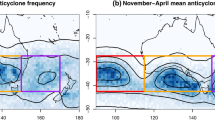Summary
A frequency analysis of anticyclones over Southern Africa and the surrounding oceans is presented during drought and wet years. It is shown that the incidence of anticylones tends to be higher over the Atlantic Ocean during drought years. Wet years show an increased frequency of anticyclonic centres off the south-east coast of South Africa. An outbreak of cold air tends to be associated with the mobile anticyclones which move round the South African coast into the Indian Ocean. These cold air outbreaks are mostly characterized by an abrupt drop in temperature over Zimbabwe and a marked intensification of the prevalent low level south-easterly flow. Tropical convection associated with quasi-stationary systems within the ITCZ tends to intensify on the arrival of the surge winds. This enhancement of convection continues until the arrival of cold air which stabilizes the tropical atmosphere.
Similar content being viewed by others
References
Flocas, A., 1983: The annual and seasonal distribution of fronts over central southern Europe and the Mediterranean.Climatol.,4, 255–267.
Harrison, M. S. J., 1983: The Southern Oscillation, zonal equatorial circulation cells and South African rainfall. Preprints, First International Conference on the meteorology of the Southern Hemisphere.
Harrison, M. S. J., 1984: A generalized classification of South African Summer rain-bearing synoptic systems.J. Climatology,4, 547–560.
Harrison, M. S. J., 1986: A Synoptic Climatology of South African Rainfall Variation. Unpublished Ph.D. Thesis, University of the Witwatersrand, 341 pp.
Hattle, J. B., 1979: Revised final report: Guti project. Met. Notes, Ser. A. No. 11, Zimbabwe Meteorological Services
Hutchinson, P., 1974:The Climate of Zambia. Zambia Geographical Association, 4 pp.
Klein, W. H., 1957: Principal tracks and mean frequencies of cyclones and anticyclones in the Northern Hemisphere. Research paper No. U.S. Department of Commerce, Washington DC.
Kidson, J. W., 1975: Eigenvector analysis of monthly mean surface data.Mon. Wea. Rev. 103, 177–186.
Lau, N. C., Lau, K. M., 1984: Structure and energetics of midlatitude disturbances accompanying cold air outbreak over East Asia.Mon. Wea. Rev. 112, 1309–1327.
Lau, K. M., Chang, C. P., Chang, P. H., 1983: Short-term planetary-scale interactions over the tropics and midlatitudes. Part II: Winter Monex period.Mon. Wea. Rev. 111, 1372–1388.
Lindesay, J. A., 1988: South African rainfall, the Southern Oscillation and a Southern Hemisphere semi-annual cycle.J. Climatol. 8 17–30.
Lindesay, J. A., Harrison, M. S. J., Haffner, M. P., 1986: The Southern Oscillation and South African Rainfall,South African Journal of Science 8, 196–198.
Longley, R. W., 1976: Weather and weather maps of South Africa. Weather Bureau, Technical Paper No. 3, 79 pp.
Miron, O., Tyson, P. D., 1984: Wet and dry conditions and pressure anomaly fields over South Africa and adjacent oceans, 1963–1979.Mon. Wea. Rev. 112, 2127–2132.
Rasmusson, E. M., Carpenter, T. H., 1982: Variations in tropical sea surface temperature and surface wind fields associated with the Southern Oscillation/El Niño.Mon. Wea. Rev. 110 354–384.
Riehl, H., 1979:Climate and Weather in the Tropics. London: Academic Press, 547 pp.
Schulze, G. C., 1986: South African rainfall related to warm and cold events. Preprint of the 2nd International Conference on Southern Hemisphere Meteorology, Amer. Met. Soc., 465–467.
Smith, A. V., 1985: Studies of the effects of cold fronts during the rainy season in Zimbabwe.Weather 40 198–202.
Taljaard, J. J., 1981: The anomalous climate and weather systems of January to March 1974. Weather Bureau, Technical Paper No. 9, 92 pp.
Taljaard, J. J., 1986: Contrasting atmospheric circulation during dry and wet summers in South Africa. South African Weather Bureau Newsletter No. 445, 1–5.
Taljaard, J. J., 1987: The anomalous climate and weather systems over South Africa during summer 1975–1976. South African Weather Bureau Technical Paper No. 16, 80 pp.
Trenberth, K. E., 1976: Spatial and temporal variations in the Southern Oscillation.Quart. J. Roy. Meteor. Soc. 91, 490–506.
Troup, A. J., 1965: The Southern Oscilation.Quart. J. Roy. Meteor. Soc. 91, 490–506.
Tyson, P. D., 1981: The atmospheric circulation variations and the occurrence of extended wet and dry spells over Southern Africa.J. Climate 1, 115–130.
Tyson, P. D., 1984: The atmospheric modulation of extended wet and dry spells over South Africa, 1958–1978.J. Climate 4 621–635.
Tyson, P. D., 1986:Climatic Change and Variability in Southern Africa. Cape Town: Oxford University Press. 220 pp.
Tyson, P. D., Dyer, T. G. J., 1978: The predicted above-normal rainfall of the seventies and the likelihood of drought in the eighties in South Africa.South African Journal of Science 74, 372–377.
Tyson, P. D., Dyer, T. G. J., 1980: The likelihood of droughts in the eighties in South Africa.South African Journal of Science 76, 340–341.
Tyson, P. D., Dyer, T. G. J., Mametse, M. N., 1975: Secular changes in South African rainfall: 1880–1972.Quart. J. Roy. Meteor. Soc. 101, 817–833.
Van Rooy, M. P., 1980: Extreme rainfall anomalies over extensive parts of South Africa during periods of 1–5 successive summer years. South African Weather Bureau Technical Paper, No. 8, 32 pp.
Williams, S. G. H., 1957: Guti at Chipinge. Met. Notes Series B. No. 14. Zimbabwe Meteorological Services.
Zillman, J. W., Johnson, D. R., 1985: Thermally forced mean mass circulations in the Southern Hemisphere.Tellus,37 A, 56–76.
Author information
Authors and Affiliations
Additional information
With 10 Figures
Rights and permissions
About this article
Cite this article
Matarira, C.H. Frequency and tracks of anticyclones and their effect on rainfall patterns over Zimbabwe. Theor Appl Climatol 42, 53–66 (1990). https://doi.org/10.1007/BF00865526
Received:
Revised:
Issue Date:
DOI: https://doi.org/10.1007/BF00865526




